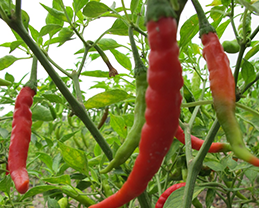Chillies
Season and seed
Soil
Well drained loamy soils rich in organic matter with pH range 6.5-7.5.
Season of sowing
1. January - February
2. June - July
3. September- October
Seed rate
Varieties: 1.0 kg / ha.
Hybrids: 200 - 250 g / ha.
Nursery area: 100 sq.m / ha.
Seed treatment
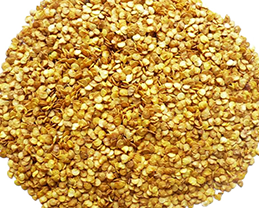
Chilli Seeds
Nursery production
Protected nursery

Nursery Bed Preparation
Cultural practices
Field preparation
Thoroughly prepare the field with the addition of FYM @ 25 t/ ha and form ridges and furrows at a spacing of 60 cm. Apply 2 kg/ha of Azospirillum and 2 kg / ha of Phosphobacteria by mixing with 20 kg of FYM. Irrigate the furrows and transplant 40-45 days old seedlings, with the ball of earth on the ridges.
Spacing
Varieties : 60 x 45 cm
Hybrids : 75 x 60 cm
Weed control
Apply Pendimethalin 1.0 kg a.i. / ha or Fluchloralin 1.0 kg a.i. / ha as pre-emergece herbicide followed by hand weeding once 30 days after planting.
Irrigation
Irrigate is done at weekly intervals.
Layout and planting for drip irrigation and fertigation
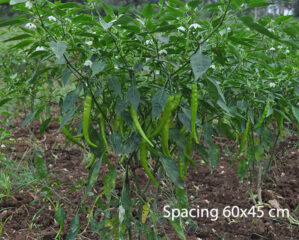
Chilli spacing
Manuring
Varieties
Basal dose : FYM 25 t/ha, NPK 30:60:30 kg/ ha.
Potassium as K2SO4 for quality improvement. Application of potassium in the form of potassium sulphate will increase quality of chilli.
Top dressing : 30 kg N/ha in equal splits on 30, 60 and 90 days after planting.
Hybrids
Basal dose : FYM 30 t / ha, NPK 30:80:80 kg / ha.
Top dressing : 30 kg N / ha in equal splits on 30, 60 and 90 days after planting.
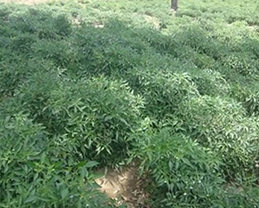
Manure required Vegetative stage
Fertigation schedule (CHILLI F1 HYBRID): Recommended Dose: 120:80:80 kg / ha
| Stage | Crop stage | Duration in days | Fertilizer grade | Total Fertilizer (kg/ha) | Nutrient applied | % of requirement | ||||
|---|---|---|---|---|---|---|---|---|---|---|
| N | P | K | N | P | K | |||||
| 1 | Transplanting to plant establishment stage | 10 | 19:19:19 MN 13:0:45 Urea | 21.05 8.88 14.86 | 4.00 1.15 6.83 | 4.00 - - | 4.00 3.98 - | 10.00 | 5.00 | 10.00 |
| Subtotal | 11.98 | 4.00 | 7.98 | |||||||
| 2 | Flower initiation to flowering | 30 | 12:61:0 13:0:45 Urea | 13.11 71.04 80.72 | 1.57 9.24 37.13 | 8.00 - - | - 31.97 - | 30.00 | 10.00 | 20.00 |
| Subtotal | 47.94 | 8.00 | 31.97 | |||||||
| 3 | Flowering set to fruit picking | 30 | 19:19:19 13.0:45 Urea | 21.05 44.40 56.91 | 4.00 5.77 26.18 | 4.00 - - | 4.00 19.98 | 30.00 | 5.00 | 30.00 |
| Subtotal | 35.95 | 4.00 | 23.98 | |||||||
| 4 | Alternate day from picking | 8 | 12:61:0 13:0:45 Urea | 6.52 35.52 40.38 | 0.75 4.62 18.57 | 3.81 - - | - 15.98 - | 30.00 | 5.00 | 50.00 |
| Subtotal | 23.94 | 3.81 | 15.98 | |||||||
| 119.81 (or) 120.00 | 19.81 (or) 20.00 | 79.91 (or) 80.00 | 100 | 25 | 100 | |||||
75% RD of Phosporous applied as superphosphate = 375 kg / ha
1. 19:19:19 = 42 kg/ha ; 2. 13:0:45 = 160 kg/ha ; 3. 12:61:0 = 20 kg/ha ; 4. Urea = 193 kg/ha
Improvement
Effect of Endo root soluble and Mycorrhizae on Chilli
Apply 250g of Endo Roots Soluble in two splits doses at 15 DAT and 45 DAT along with 100 % N and K and 50% P for higher yield and saving of Phosphorous. Apply 250g of Mycorrhiza in two splits at transplanting and 30 DAT along with 100% N and K and 50% P for higher yield and saving of Phosphorous.
Growth regulators
Spray Triacontanol @ 1.25 ml/l on 20, 40, 60 and 80th day of planting. Spray NAA 10 ppm (10 mg/l of water) on 60 and 90 days after planting to increase fruit set.
Micronutrient spray
Foliar spray of Zn SO4 @ 0.5 per cent thrice at 10 days interval from 40 days after planting.
Spray 19:19:19 + Mn @ 1 % at 60 days after planting.
Intercropping
The intercrops like onion and coriander can be grown for getting additional income. It can also help to control the weed population.
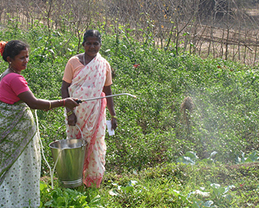
Spraying of micronutrients in Chilli
Yield
Harvest
Harvesting can be done 75 days after transplanting. First two picking yield green chilli and subsequently yield red ripe fruits.
Yield
Varieties : 2 - 3 t/ha of dry pods or 10 - 15 t/ha of green chillies.
Hybrids: 25 t / ha of green chillies.
